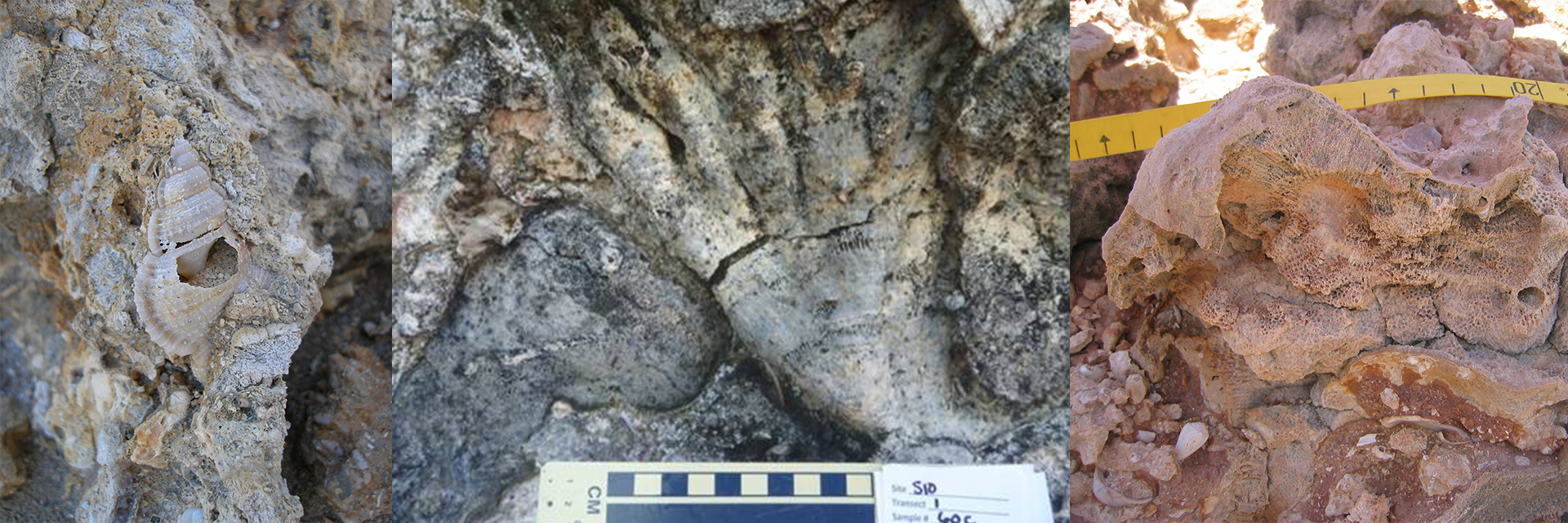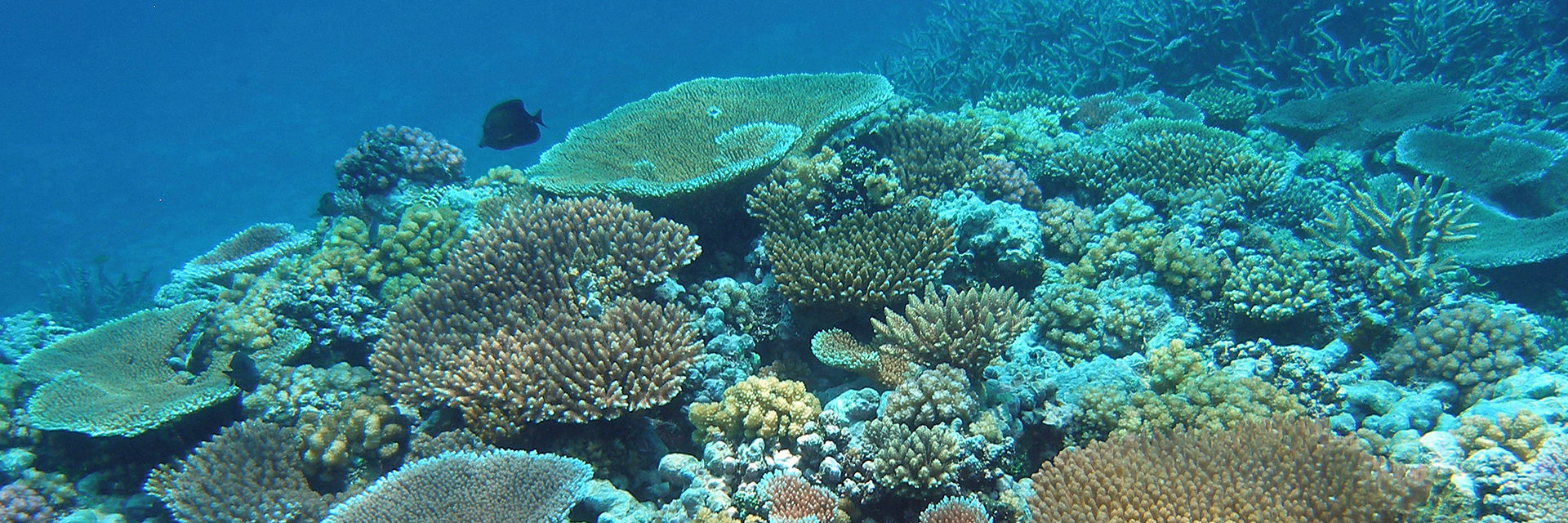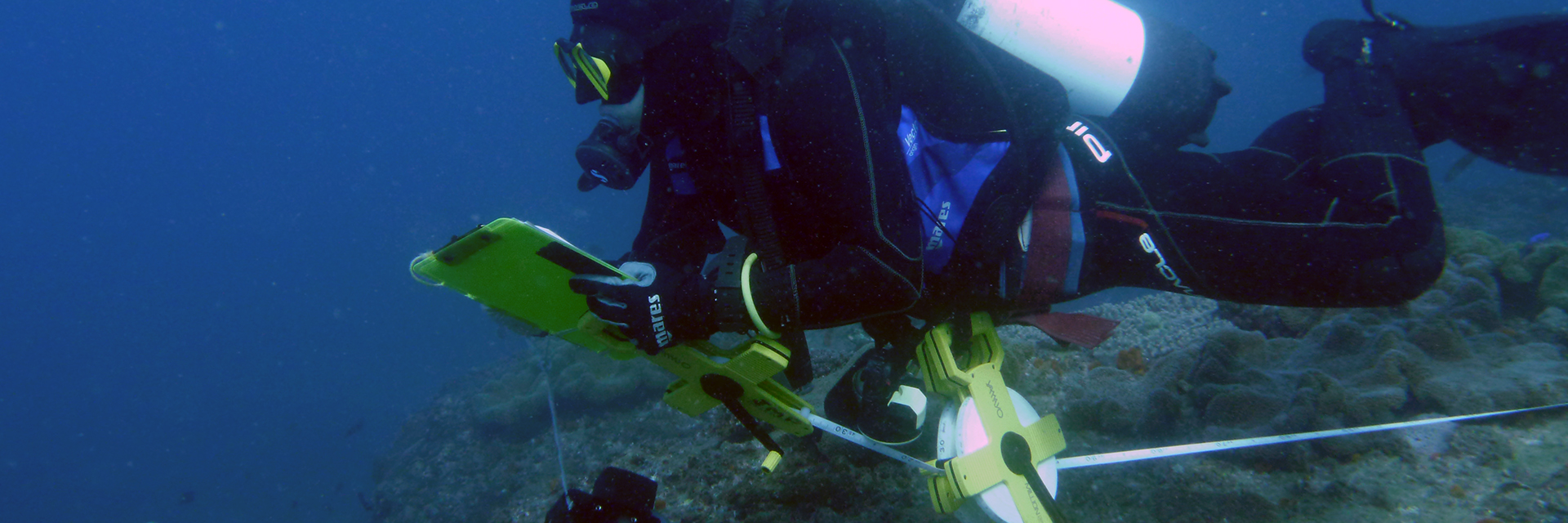The Marine Palaeoecology Lab conducts various investigations into the effects of climate change on coral reef and sub-tropical habitats using sediment coring and analysis of fossil assemblages as well as modern ecological surveys. Our cores provide important information on the response of coral reef communities to natural and anthropogenic climate change, as well as other anthropogenic stressors. Analysis of calcification of corals within cores provides long-term information on the response of individual coral species to changing sea surface temperatures and aragonite saturation states.
1) Ecological dynamics and conservation of subtropical coral reef communities of east Australia in changing climate
 Subtropical reefs are increasingly threatened by both human stressors and climate change. They exist in close proximity to environmental limits of temperature, salinity, light availability and aragonite saturation, and are exposed to high rates and magnitudes of fluctuation in environmental conditions. The current oceanographic climate is changing at a much faster rate than in the past, which may result in more frequent or more severe extreme events in temperature, wind and waves, increasing stress regimes on subtropical reefs. Understanding how reefs function is critical to predicting how they will adapt to change, and to their long-term effective management.
Subtropical reefs are increasingly threatened by both human stressors and climate change. They exist in close proximity to environmental limits of temperature, salinity, light availability and aragonite saturation, and are exposed to high rates and magnitudes of fluctuation in environmental conditions. The current oceanographic climate is changing at a much faster rate than in the past, which may result in more frequent or more severe extreme events in temperature, wind and waves, increasing stress regimes on subtropical reefs. Understanding how reefs function is critical to predicting how they will adapt to change, and to their long-term effective management.
Subtropical reef communities may be instrumental for the survival of coral reef organisms through geological time and act as refuges for tropical corals. Understanding these communities provides a glimpse of the potential future of current tropical coral reefs that may become marginal under climate change.
This project aims to contribute to this understanding, and examines the temporal and spatial dynamics of subtropical reef communities.
Researchers:John Pandolfi, Maria Beger, Brigitte Sommer, Eugenia Sampayo
Collaborators:
Peter Harrison, Southern Cross University
Russ Babcock, CSIRO
Steve Smith, Southern Cross University
2) Predicting coral reef response to climate change: past and present comparison
An understanding of the past response of coral reef ecosystems to climate change is essential for predicting ecosystem response to IPCC (2007) projected climate change for the next century. Pleistocene coral reefs experienced large temperature and CO2 fluctuations that influenced species distribution patterns on multiple temporal and geographic scales. Our knowledge of these ancient reefs is now at a sufficient level to conduct a global-scale macro-ecological meta-analysis of changes in species distribution patterns from the Late Pleistocene (500 ka to 80 ka; ka = thousand years ago) through the Holocene (past 10 ka) to the modern living coral reef. Our analytical approach covers three levels: 1) Global scale – biogeography (species vs genus; abundance vs presence/absence); 2) Regional scale – beta diversity/turnover; and 3) Local scale – community ecology/stability through time. We are gathering comprehensive distributional data on Pleistocene and living coral reefs, including corals and molluscs.
Researchers:John Pandolfi
Collaborators:
Wolfgang Kiessling, GeoZentrum Nordbayern
3) Calcification of the scleractionian coral Goniopora spp. on two inshore reefs of the Great Barrier Reef over the last millennium
Seasonal density banding in coral skeletons offers a unique key to unravelling coral growth through time. Optical densitometry from x-radiographs will be used to calculate annual linear extension and skeletal density – thus calcification – of Goniopora spp. fragments from the coral reef matrix. This pre- industrial revolution baseline, extending back 1000 years, will allow analyses of past, present, and future relationships between environmental stressors and coral growth.
Researchers:John Pandolfi, Brent King
4) Marine biotic response to global climate change
I am part of a National Center for Ecological Analysis and Synthesis (NCEAS) working group on ‘Towards Understanding Marine Biological Impacts of Climate Change’. This Working Group is providing a globally coherent view of marine biological changes in response to climate change that is currently lacking but so desperately needed. We are addressing key questions concerning the vulnerability of marine systems to climate change:
1. What are the similarities and differences between marine and terrestrial systems in terms of types and rates of responses?
2. Which marine species, taxonomic groups and systems (e.g., pelagic, benthic, rocky shore, sandy beach, coral reef) are most sensitive?
3. What are the similarities and differences in the types and rates of responses in tropical, temperate and polar seas?
4. Do multiple human stresses increase vulnerability of species and habitats to climate change?
5. Can we attribute change in marine ecosystems to climate change?
To answer these key questions, we are undertaking three tasks:
Task 1: Database assembly – Build a marine climate impacts database employing an innovative tiered approach to classify impacts. The database will soon be publicly-accessible through the NCEAS data repository, enabling researchers to validate entries and upload new results.
Task 2: Impacts analysis – Addressing the first 4 key questions above by applying robust meta-analytic techniques to the marine climate impacts database.
Task 3: Attribution – Employing the analytical techniques of the IPCC (2007) and others to attribute changes in marine biological ecosystems to global warming with a high degree of certainty (key question 5).
Researchers:John Pandolfi
Collaborators:
NCEAS
5) Coral sand climate change
Researchers:John Pandolfi
Collaborators:
Centre of Ocean Science WG
6) Foraminifera response to climate change and local impacts
The Great Barrier Reef (GBR) is currently facing serious declines due to global and local changes in the ocean environment. Annual sea surface temperatures in the GBR have already risen by 0.4°C within the last century and are likely to increase 1-3°C by the end of 2100. Increased ocean temperatures have significant negative impacts on coral communities, the most significant arising from mass global bleaching events that cause widespread mortality amongst coral communities. On more local scales, decreasing water quality due to anthropogenic influence is of particular concern for the GBR, where numerous coral communities lie in the path of river flood plumes, placing them in the proximity of changes in nutrient loads and other pollutants, and different light regimes. Coral reef fauna such as reef building corals and large benthic foraminifera (LBF) are well adapted to live under low-nutrient conditions due to their symbiotic relationship with primary producers (i.e., dinoflagellates and diatoms). Changes in nutrient loads thus have the potential to disrupt the finely balanced nutrient cycling pathways of the symbiotic relationship and, similar to corals, LBF are particularly sensitive to macroalgal overgrowth under elevated nutrients and increased temperature. In comparison to corals, LBF respond faster to environmental changes, and their smaller size and shorter life spans make them a good model system to study the response of reef invertebrate symbioses to changes in water quality.The proposed research aims to assess biochemical, physiological and morphological changes associated with oxidative stress and biomineralization in LBF, by quantifying stress response to varying levels of temperature, light and nutrients (i.e., nitrate). Health assessment will be made using novel biomarker tools, which allow a detailed measurement of a range of biochemical alterations, for example enzymatic activity disruption. These measurements will be used to calibrate the severity and extent of morphological and visible responses such as bleaching (loss of symbionts) and growth deformities of calcified shell structures. This approach will allow us to significantly improve our understanding of how current and future predicted increases in nutrient loading and climate change will interact and affect the life history, morphology and physiology of LBF species, and will assess the potential for using LBF as bioindicators of shifts in the environment caused by local and global changes on the GBR.
Researchers: John M. Pandolfi, Martina de Freitas Prazeres
Collaborator: Sven Uthicke, Australian Institute of Marine Sciences






